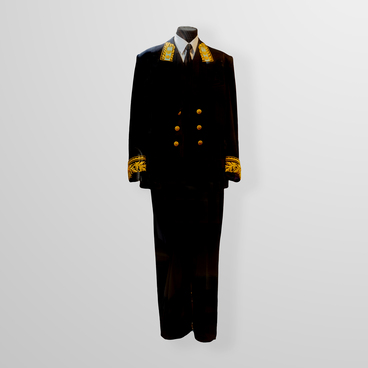This vase with landscape painting, made in 1904 at the Imperial Porcelain Factory, is a typical example of the Art Nouveau style in the decorative and applied arts of the early 20th century. The narrow lower part of the body gradually widens upwards. The edge is smooth. The colors of the decor range from light to dark-gray. The body features a landscape of a river and trees with a birch tree in the foreground.
All the living quarters of the second floor of the Livadia Palace were decorated in the fashionable Art Nouveau style. The architect Nikolay Krasnov designed individual furniture for each room, choosing exquisite materials and upholstery fabrics in accordance with his own distinctive manner. However, what proved to be particularly important and demanding was the work he did in decorating the interiors. The architect created a special artistic look for each room, where all the interior elements were carefully thought through.
As the interior decoration work was completed, the rooms of the palace were filled with a large number of paintings, drawings, and works of decorative and applied arts: porcelain and crystal vases, figurines, articles of bronze and carved stone, wall and floor lamps, candelabrums, chandeliers, and sculptures. A considerable part of these items included vases of various shapes and sizes by European manufacturers, such as Meissen, Sevres and Gardner Porcelain factories, as well as those produced in Russia at the Popov, Kuznetsov and the Kornilov brothers’ plants. Many pieces were made at the Imperial Porcelain Factory.
During the reign of Emperor Nicholas II (1894–1917), the Imperial Porcelain Factory enjoyed an exemplary state in terms of technical and technological innovations. A special achievement and pride of this factory was a vast array of artistic techniques. It is quite natural that in designing products the flourishing factory used the increasingly popular Art Nouveau style, the main idea of which was to abandon regular geometric forms in favor of more natural ones.
A technique of underglaze painting which best revealed the possibilities of the material and was in line with the aesthetics of Art Nouveau was introduced at the Imperial Porcelain Factory in the 1890s. The shapes of the products were simplified as much as possible to allow more space for painting.
All the living quarters of the second floor of the Livadia Palace were decorated in the fashionable Art Nouveau style. The architect Nikolay Krasnov designed individual furniture for each room, choosing exquisite materials and upholstery fabrics in accordance with his own distinctive manner. However, what proved to be particularly important and demanding was the work he did in decorating the interiors. The architect created a special artistic look for each room, where all the interior elements were carefully thought through.
As the interior decoration work was completed, the rooms of the palace were filled with a large number of paintings, drawings, and works of decorative and applied arts: porcelain and crystal vases, figurines, articles of bronze and carved stone, wall and floor lamps, candelabrums, chandeliers, and sculptures. A considerable part of these items included vases of various shapes and sizes by European manufacturers, such as Meissen, Sevres and Gardner Porcelain factories, as well as those produced in Russia at the Popov, Kuznetsov and the Kornilov brothers’ plants. Many pieces were made at the Imperial Porcelain Factory.
During the reign of Emperor Nicholas II (1894–1917), the Imperial Porcelain Factory enjoyed an exemplary state in terms of technical and technological innovations. A special achievement and pride of this factory was a vast array of artistic techniques. It is quite natural that in designing products the flourishing factory used the increasingly popular Art Nouveau style, the main idea of which was to abandon regular geometric forms in favor of more natural ones.
A technique of underglaze painting which best revealed the possibilities of the material and was in line with the aesthetics of Art Nouveau was introduced at the Imperial Porcelain Factory in the 1890s. The shapes of the products were simplified as much as possible to allow more space for painting.


